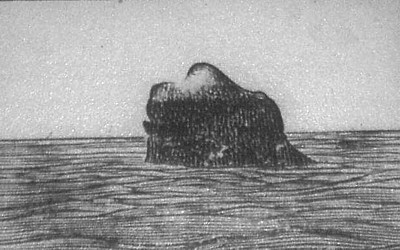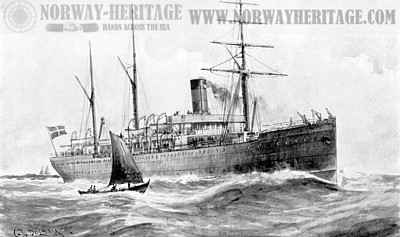The Sinking of the Norge
by Dan Hovland
Eight years before the Atlantic Ocean claimed the Luxury Ship titanic, a Danish steamer, the Norge, left the Norwegian port of Trondheim [*], bound for America. Among the nearly 800 passengers were Justina Maria Wedin and her nine children. Justina and her family were on their way to join her husband, Martin Wedin, who had been working in Minnesota, trying to establish a home in Morrison County. Martin and Justina were married in Borgvattnet, Sweden, in 1884. With a new child being brought into their world every couple of years, their poor farm did not hold much promise for the future. Martin traveled to Minnesota to work and find a home for his family.
He found work in the woods near Duluth, cutting wood, and also worked for his sister's husband, John S. Borgstrom, who at that time was farming and running a store in the settlement in Upsala in southwestern Morrison County, MN. During those years Martin made several trips back to see his family. By the spring of 1904, Martin had earned enough to pay for the tickets his family needed to join him. Justina was then responsible to get her children ready to cross the Atlantic and go on to Minnesota. By this time there were nine children: Martin Jr., 19; Johan, 18; Alma, 15; Fridolf, 13; Frida, 11; Frans, 8; Thure, 4; Hugo, 3 and Ruben, 1. Justina was an able mother and prepared her children with diligence and excitement. They sold their humble home and belongings at an auction. In mid-June they left their friends and traveled by horse and wagon, as well as train, to Trondheim. There [*] they boarded the steamship, Norge, joining nearly 800 other Scandinavians. The first few days of the trip were both beautiful and pleasant. Then came the 28th of June. Three hundred miles west of Scotland, sleeping passengers were jolted from their slumber by a loud grinding, rasping sound. The Norge's bow had struck the rocks around the sixty-foot Rockall Cliff, tearing a hole in the hull.

A newspaper picture of the cliff Rockall after the S/S Norge disaster in 1904
Clanging bells signaled crewmembers to stop the engines. Pumps were engaged and passengers were instructed to put on life belts. Lifeboats were readied and passengers began to board them. The nose of the ship was pinned directly against the rocks. Captain Gundell ordered the engine room to reverse the engines to pull the ship off. Unfortunately, the damage was sever and as soon as the ship was away water began pouring into the hold. Panic broke out as the catastrophic nature of the situation became evident. The passengers who were piled into the few boats being lowered were the fortunate ones, while the others could see they were about to go down with the rapidly sinking Norge. Justina Wedin stood by the railing with her children, wondering if any of them would be saved. Far below she saw a lifeboat filled with people. With despair in her heart she took her four-year-old son, Thure, and cast him into the boat, just as it was rowed away. Her eldest son, Martin, fearing the fate of his brother, jumped into the water and swam after the boat. He pleaded to those in the boat to let him in, but fearing it was too full, they pushed him away. Suddenly, a large wave swelled up below him and lifted him right into the boat where he was safe from the sea. Justina and her seven other children were not to be saved. Less than twenty minutes after striking the rocks, the Norge plunged beneath the waves, taking nearly 700 passengers with her. The English Steamship Cerwona eventually picked up the boat that the Wedin boys were in. Young Thure had been injured in his fall to the lifeboat and developed typhoid fever. He recovered, however, with the help of his brother and kind people in Scotland. It was a devastating blow when news of the disaster reached Martin Sr. He left his work near Duluth, MN. They would share his grief, but they could not remove it. Martin did not know at first that two of his sons had been saved until a telegram arrived from Scotland. It was bittersweet news but provided something for him to look forward to. In August, Martin Jr. and Thure arrived in Upsala. They were greeted by a large number of people who did their best to bid them welcome and show their sympathy to the father and his two sons for their tremendous loss. The loss of Justina Wedin and her family was felt deeply in Sweden, too. They had been an import part of their community and their memory stayed with them. Fifty years after the disaster, a memorial plaque was placed at the site of the Wedin home in Borgvattner. Martin Wedin Sr. showed great courage and went on with his life. In 1909 he married Hilma Anderson of Alexandria.
They lived on a farm just west of Upsala. Martin died June 21, 1950 at the age of ninety-one. Martin Jr. (known as little Martin) eventually moved to Duluth. He and wife Astrid, had seven children. He did September 12, 1950. Thure (known as Lawrence) was raised by John and Anna Borgstrom.
He ran a business in Upsala for a while, married Myrtle Berg and had four sons. Lawrence moved to California where he died in June 1978.
Sources: Interviews with Frances Wedin Groth (daughter of Martin Wedin, Sr.), Myrtle Wedin Mockros (cousin to Frances, and Muriel Berg Peterson. Papers belonging to Myrtle Mockros, including: "Landheim, Arvid." "For fifty years, a Tragic Memory", 1954 (translated by K. John Olson). "Many Lost At Sea", from "Nordstjernan (1846-1996, No. 17, Vol. 17. Newspaper articles from the Ostersunds-Posten, August 12, 1989 (including story of shipwreck and Myrtle Mockros trip to Sweden; translated by Anna Smedman, Feb. 1998). Little Falls Daily Transcript, July 5-9 and August 24, 1904 (located at Morrison County Historical Society). Photographs from Upsala Area Historical Society. Morrison and Todd County Minnesota, 1915, Axel Martin Borgstrom history, p. 404 (located at Morrison County Historical Society).
[* - The passengers from Trondhjem actually boarded the ship in Kristiania (now Oslo) after traveling from Trondhjem to Kristiania by train]

Norge, Thingvalla and Acandinavian America Line steamship
Support Norway Heritage: Purchase a copy 